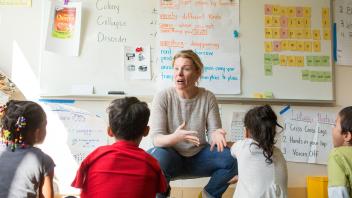Last week, I provided a link to a close reading video that a reader sent me. The link purported to present a model “close reading” lesson.
Although, there was much to like about the lesson, I complained that it wasn’t close reading. Close reading is not a synonym for reading comprehension (or even “really good reading comprehension”).
This is happening a lot. A company says their anthologies include “complex text,” but it isn’t clear what teachers are supposed to do with it, or why it’s there at all since the instructional procedures still seem to favor the idea of protecting kids from complex text.
Last week I dinged that video for claiming that close reading is a teaching technique (it’s an approach to reading). I was critical of the idea that close reading helps students “conquer complex text,” if that includes language complexity as measured by Lexiles. I didn’t like the idea of reading the book to the kids; I’m a fan of reading texts to kids (see a recent NewYork Times article on this), but not the texts the kids are supposed to be reading. Finally, I didn’t like how rereading was being approached.
Here is the rest of my thinking about this lesson. Hope it’s useful to you.
1. Confusion of story and exposition.
A big issue with the standards is the shift to informational text. Unfortunately, teachers lack experience teaching informational text, and they haven’t developed a language for it yet. In the video the teacher repeatedly refers to the “story” that the students are reading. Better choices: “informational text,” “book,” “article,” “science selection,” and so on.
Our language cues kids as to which strategies to use and what text features to rely on. Stories have different characteristics than science articles do. They are organized differently and use language in different ways.
2. The terrific teaching strategies are irrelevant to close reading.
Many teachers who watch the video are going to be impressed with the clever way the teacher had kids sharing information (the back-to-back arrangement, the whip around). Those are clever techniques and I’m all for them. They’re the kind of thing that allows effective teachers to reap the benefits of small group instruction even when teaching a whole class. As a teacher educator, I’d be very pleased if my students walked away from this viewing with those techniques.
However, those techniques have nothing to do with close reading. A lesson will involve students in close reading whether or not those techniques are used. (That’s why this can be a “good lesson” — because of the high engagement level of the students — but a poor lesson, if the goal was to engage them in close reading.
3. Close reading focuses on the text, not the reading strategies.
A major purpose of close reading was to shift readers’ attention from authors’ biographies, the historical period from which the text emerged, or from past critical response. It aimed to shift this attention to the text itself.
One of the biggest problems with the presentation is its heavy emphasis on main idea and key detail detection, annotation techniques, rereading procedures. What the author had to say and how the author said it is getting lost here. That’s why I see this lesson as no different from what was common in schools in the 1960s, 70s, 80s, 90s, and the Oughts. This isn’t an advance; it is just a new set of labels for what we were doing before.
I do believe that, as teachers, we need to teach the reading process to kids, and having some lessons that focus on how to summarize or question a text makes great sense. Similarly, I’m all for explicitly teaching kids some of the common ways that texts are organized and to have them practice reading texts to use those strategies or to figure out a text’s structure. But, as useful as such lessons can be, they are different than the lessons in which the emphasis should be entirely upon the content and approach of a particular text.
One can’t really tell from the video when certain things happened (is this what the teacher started with or did she tell the kids this after they had read the text once or twice?). One example is purpose. She stresses that the purpose is to get the main idea and details and then tells students to look for the main ideas (she even helps this along by asking them what they know about adaptation). The problem is that her purposes are more about the reading process than the text.
A model lesson on close reading should stress the text, not the reading strategies. And, it should focus attention on not just what the text said, but how the author expressed, reinforced, or extended the meaning through his/her choices of language and structure. This lesson ignored tone, the role of illustrations, why the author chose particular words, or why information was sequenced in particular ways. Kids will likely come away with some of the facts (and that is good), but there is more to it.
About the Author
Literacy expert Timothy Shanahan shares best practices for teaching reading and writing. Dr. Shanahan is an internationally recognized professor of urban education and reading researcher who has extensive experience with children in inner-city schools and children with special needs. All posts are reprinted with permission from Shanahan on Literacy .

